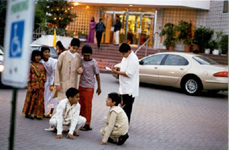Search for:
Social
History
>
Tushar Unadkat Part 1 / Part 1 of 2 (continued in Part
2)
Home Away
from Homeland
By Tushar Unadkat
A non-resident Indian (NRI)
is an Indian citizen who has migrated to another country, a person
of Indian origin who is born outside India, or a person of Indian
origin who resides outside India. Other terms with the same meaning
are overseas Indian and expatriate Indian. In common usage, this
often includes Indian born individuals (and also people of other
nations with Indian blood) who have taken the citizenship of
other countries.
A Person of Indian Origin (PIO)
is usually a person of Indian origin who is not a citizen of
India. For the purposes of issuing a PIO Card, the Indian government
considers anyone of Indian origins up to four generations removed
to be a PIO.
The NRI and PIO population
across the world is estimated at over 30 million (not including
Pakistani, Bangladeshi and Sri Lankan Diasporas).
The Indian government recently
introduced the "Overseas Citizenship of India (OCI)"
scheme in order to allow a limited form of dual citizenship to
Indians, NRIs and PIOs for the first time since independence
in 1947. It is expected that the PIO Card scheme will be phased
out in coming years in favour of OCI.
In the past decade during my
international travel, I produced a photographic research titled,
'Home away from homeland' <http://www.tusharunadkat.com/journalism.htm>
The theme of this exhibition
is concerned with the experience of various generations of Indians
living abroad who try to retain aspects of the life they remember
before they left India. After one or two generations Indians
seem to find themselves in a time warp that relates to an India
that no longer exists, except in the memory of their grandparents.
In some ways their way of living Indian culture is more traditional
than is possible in contemporary India. Thus, through the practice
of photography, a body of work is created on the theme of 'Home
away from homeland'.
 Here
the word 'Indian' is used in the broadest sense and includes
Pakistanis, Bangladeshis, and Sri Lankans. These images focus
on the social, commercial, cultural, religious and day-to-day
activities of Indians and observe the fine blending of different
cultures. The intention was to capture what Indians have adapted
from the West and vice-versa.
Here
the word 'Indian' is used in the broadest sense and includes
Pakistanis, Bangladeshis, and Sri Lankans. These images focus
on the social, commercial, cultural, religious and day-to-day
activities of Indians and observe the fine blending of different
cultures. The intention was to capture what Indians have adapted
from the West and vice-versa.
"I chose this theme because,
as an Indian abroad myself, I share the concerns and experiences
of my fellow exiles. I am both an observer and a subject."
As a part of the research this
work has traveled around in England, Scotland, Germany, New York
and Canada to compare the differences and similarities between
the Indians in different parts of the West.
In 1961, the local authorities
of the city of Leicester in England and Krefeld in Germany declared
the cities as "twin" towns. It is said that Leicester
has the largest Indian population in Europe. Hence the purpose
of choosing Krefeld in Germany was to investigate the Indian
community in the "twin" town of Leicester. To compare
the lifestyles of the 'Indian' in different parts of the West,
a study was then conducted in New York and Canada.
The work is addressed to various
audiences. For example, for those Indians who cannot travel abroad,
it will be an awareness-raising project that expresses the significance
of their community in foreign lands. It could also target the
population of different countries, to inform them about the Indians
who live amongst them and their special culture.
A new flavour on this project
can be seen through the images taken in India, of the Non Resident
Indians (NRI). The aim of this exhibition is to establish a visually
recorded history of Indians living abroad before the Millennium.
Indians in the UK
The Indian emigrant community
in the United Kingdom is now in its third generation. As an immigrant
group, people of Indian origin have been remarkably successful.
Indians in the UK are the largest community outside of Asia percentage
wise, and the second largest population wise, only surpassed
by the United States.
Indian culture has been constantly
referenced within wider British culture, at first as an "exotic"
influence in films like 'My Beautiful Laundrette', but now increasingly
as a familiar feature in films like 'Bend It Like Beckham'. Indian
food is now regarded as part of the British cuisine.
According to the UK National
Census, in 2008 there are likely to be well over 1,600,000 citizens
of Indian origin in the UK.
(continued in Part
2)
Photo Credit:
Tushar Unadkat
<<
top
 The project was made
possible with the support of the
The project was made
possible with the support of the
Department
of Canadian Heritage through the Canadian Culture Online Strategy
The Acrobat Reader
is available free from 